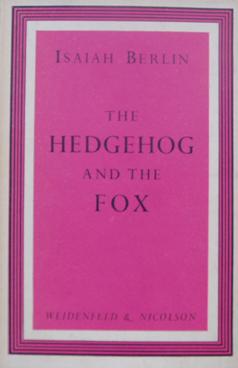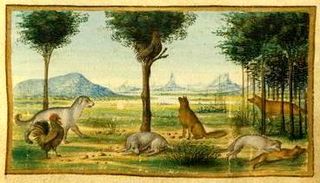
Fable is a literary genre defined as a succinct fictional story, in prose or verse, that features animals, legendary creatures, plants, inanimate objects, or forces of nature that are anthropomorphized, and that illustrates or leads to a particular moral lesson, which may at the end be added explicitly as a concise maxim or saying.

Ivan Andreyevich Krylov is Russia's best-known fabulist and probably the most epigrammatic of all Russian authors. Formerly a dramatist and journalist, he only discovered his true genre at the age of 40. While many of his earlier fables were loosely based on Aesop's and La Fontaine's, later fables were original work, often with a satirical bent.

Aesop's Fables, or the Aesopica, is a collection of fables credited to Aesop, a slave and storyteller who lived in ancient Greece between 620 and 564 BCE. Of diverse origins, the stories associated with his name have descended to modern times through a number of sources and continue to be reinterpreted in different verbal registers and in popular as well as artistic media.

"The Tortoise and the Hare" is one of Aesop's Fables and is numbered 226 in the Perry Index. The account of a race between unequal partners has attracted conflicting interpretations. The fable itself is a variant of a common folktale theme in which ingenuity and trickery are employed to overcome a stronger opponent.

The Fox and the Grapes is one of Aesop's Fables, numbered 15 in the Perry Index. The narration is concise and subsequent retellings have often been equally so. The story concerns a fox that tries to eat grapes from a vine but cannot reach them. Rather than admit defeat, he states they are undesirable. The expression "sour grapes" originated from this fable.
The Deer without a Heart is an ancient fable, attributed to Aesop in Europe and numbered 336 in the Perry Index. It involves a deer who was twice persuaded by a wily fox to visit the ailing lion. After the lion had killed it, the fox stole and ate the deer's heart. When asked where it is, the fox reasoned that an animal so foolish as to visit a lion in his den cannot have had one, an argument that reflects the ancient belief that the heart was the seat of thoughts and intellect. The story is catalogued as type 52 in the Aarne-Thompson classification system.
The lion's share is an idiomatic expression which now refers to the major share of something. The phrase derives from the plot of a number of fables ascribed to Aesop and is used here as their generic title. There are two main types of story, which exist in several different versions. Other fables exist in the East that feature division of prey in such a way that the divider gains the greater part - or even the whole. In English the phrase used in the sense of nearly all only appeared at the end of the 18th century; the French equivalent, le partage du lion, is recorded from the start of that century, following La Fontaine's version of the fable.

"The Town Mouse and the Country Mouse" is one of Aesop's Fables. It is number 352 in the Perry Index and type 112 in Aarne–Thompson's folk tale index. Like several other elements in Aesop's fables, "town mouse and country mouse" has become an English idiom.

The Hedgehog and the Fox is an essay by philosopher Isaiah Berlin that was published as a book in 1953. It was one of his most popular essays with the general public. However, Berlin said, "I meant it as a kind of enjoyable intellectual game, but it was taken seriously. Every classification throws light on something". It has been compared to "an intellectual's cocktail-party game".
The Cat and the Mice is a fable attributed to Aesop of which there are several variants. Sometimes a weasel is the predator; the prey can also be rats and chickens.

The Fox and the Crow is one of Aesop's Fables, numbered 124 in the Perry Index. There are early Latin and Greek versions and the fable may even have been portrayed on an ancient Greek vase. The story is used as a warning against listening to flattery.

The Tortoise and the Birds is a fable of probable folk origin, early versions of which are found in both India and Greece. There are also African variants. The moral lessons to be learned from these differ and depend on the context in which they are told.
The Lion, the Bear and the Fox is one of Aesop's Fables that is numbered 147 in the Perry Index. There are similar story types of both eastern and western origin in which two disputants lose the object of their dispute to a third.

The Mouse Turned into a Maid is an ancient fable of Indian origin that travelled westwards to Europe during the Middle Ages and also exists in the Far East. The story is Aarne-Thompson type 2031C in his list of cumulative tales, another example of which is The Husband of the Rat's Daughter. It concerns a search for a partner through a succession of more powerful forces, resolved only by choosing an equal.
The Bear and the Gardener is a fable originating in the ancient Indian text Panchatantra that warns against making foolish friendships. There are several variant versions, both literary and oral, across the world and its folk elements are classed as Aarne-Thompson-Uther type 1586. The La Fontaine version has been taken as demonstrating various philosophical lessons.

The Cock, the Dog and the Fox is one of Aesop's Fables and appears as number 252 in the Perry Index. Although it has similarities with other fables where a predator flatters a bird, such as The Fox and the Crow and Chanticleer and the Fox, in this one the cock is the victor rather than victim. There are also Eastern variants of this story.
The Hawk and the Nightingale is one of the earliest fables recorded in Greek and there have been many variations on the story since Classical times. The original version is numbered 4 in the Perry Index and the later Aesop version, sometimes going under the title "The Hawk, the Nightingale and the Birdcatcher", is numbered 567. The stories began as a reflection on the arbitrary use of power and eventually shifted to being a lesson in the wise use of resources.

Jean de La Fontaine collected fables from a wide variety of sources, both Western and Eastern, and adapted them into French free verse. They were issued under the general title of Fables in several volumes from 1668 to 1694 and are considered classics of French literature. Humorous, nuanced and ironical, they were originally aimed at adults but then entered the educational system and were required learning for school children.
The Hedgehog and the Fox may refer to:
The fable of The Fox, the Flies and the Hedgehog is ascribed to Aesop’s Fables. From its beginning it was applied satirically to political leaders and is numbered 427 in the Perry Index.












